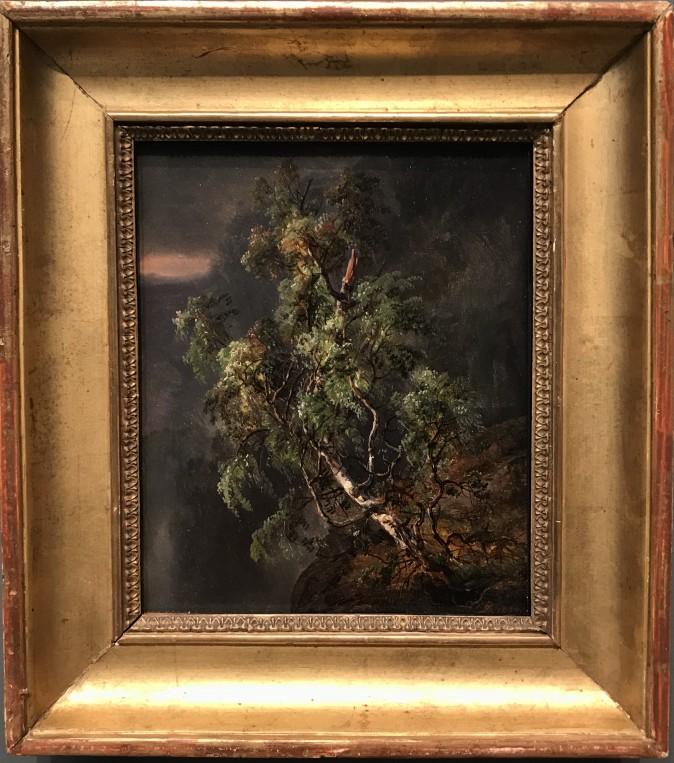NEW YORK—“The beauty of nature takes the leading role,” wrote the Norwegian artist Peder Balke (1804–1887) about his journey to Finnmark. The northernmost point of continental Europe left a lasting impression on this seascape painter, giving him inspiration for the rest of his years.
You can experience his journeys vicariously through his paintings of the sublime, via an exhibit at The Metropolitan Museum of Art, “Peder Balke: Painter of Northern Light,” running until July 9. Every painting on display of the recently rediscovered artist exalts the power and beauty of nature.
Dramatic light piercing through majestic clouds in an otherwise dark ocean, towering peaks looming in the far distance, or a boat holding human figures who are tiny in comparison to waves thrusting toward ominous cliffs are some reoccurring features in Balke’s paintings. Together, they ultimately attest to nature’s inevitably humbling force upon humans, characteristic of northern Romantic painting.
[gallery size=“large” ids=“2249080,2249091,2249084”]
Balke seems to have been so transfixed by nature that it drove him to represent it in his own idiosyncratic way. Reflecting on his journey in 1850, Balke wrote:
“Nor is any pen capable of describing the grandiose and enchanting impression made on the eye and the mind by the wealth of natural beauty and the incomparable situations, an impression that not only overwhelmed me then and there, in the intoxication of the moment, but also had a decisive influence on the whole of my life, in that I have never, either abroad or in other parts of the country, had occasion to see anything equally exalting and inspiring as that which I witnessed on this journey to Finnmark.”
Born into a family of landless peasants on the remote island of Helgoya in the middle of Mjosa, Norway’s largest lake, Balke was not hindered by his humble and remote circumstances. Showing promise as a young painter, he first trained with local artisans and was exposed to and learned from great art of the past, but maintained his own personal style.
“Balke was a bit of a maverick. He was ambitious, and he was kind of fearless, given his background. From a very early age, he was introducing himself to royalty, making pictures for them, and was not discouraged by the fact that he did not paint like his contemporaries,” said Asher Ethan Miller, assistant research curator in The Met’s European paintings department, during a press viewing.
Balke traveled extensively, including to Copenhagen, Berlin, Paris, London, and St. Petersburg, Russia. He sought academic training in Oslo and then in Stockholm from 1829 to 1833. In Dresden, Germany (from 1835 to 1836), he met the two great landscape artists Caspar David Friedrich (1774–1840) and Johan Christian Dahl (1788–1857).

While Balke admired and emulated Dahl, “he never really abandoned the craftsman-like approach to painting that he had learned in his youth,” Miller said. “He doesn’t paint in glazes, and he doesn’t hide his brushstrokes. There aren’t translucent layers of paint, layered one on top of the other.”
It’s not certain whether Balke was unable to paint like Dahl, who mentored him, or like Friedrich, who painted according to the academic tradition, or whether it was simply his conscious stylistic decision to paint more directly. “Throughout his career, he continuously finds his very personal manner of painting,” Miller said.
Of the 25 paintings in the exhibitition, eight are by Balke’s contemporaries, giving a bit of context to the exhibit’s selection of his oeuvre. Typical of 19th-century Norwegian artists, they were all forging a link between landscape painting and national identity, in a similar way to the Hudson River School artists in the United States at the same time.
[gallery size=“large” ids=“2249082,2249089,2249092”]
While Balke obviously loved nature, he did not paint onsite but from memory. “He painted very forthrightly, all as a means of expressing his sensibility and of really externalizing a very deep and profound memory for a place that he identified with,” Miller said.
In his later work, starting at around 1855, Balke increasingly painted on craftsman-like materials, such as sections of wood planking. He would use a white ground (base layer) and then apply a layer of black paint. With either a dry brush or some other kind of tool, he scraped through the paint to let the white ground show through, in order to create the mid-tones and highlights in his compositions. These later paintings are especially unique for his time. They are endearing in their small size, yet stunning and extraordinary in their emotional impact.

After 1849, Balke settled back in Oslo. Toward the end of the 1860s, it seems he became estranged from the main art scene in the city. He established a kunstnerlund (artist’s grove), with homes for workers and craftsmen, which eventually burned down in 1879. That is the same year as his last known dated painting. When he died eight years later, obituaries mentioned he was a respected citizen, but not an artist.
Posthumously, Balke returned to the public eye in 1914 when there was a jubilee exhibition celebrating the centennial of Norway’s constitution. Recently, in 2014 and 2015, the National Gallery in London held a large exhibition of more than 50 of his paintings.
“Peder Balke: Painter of Northern Light” is the first exhibit of this rediscovered artist in the United States. It will be on view in the European Paintings Gallery at The Met Fifth Avenue until July 9.
Follow @milenefernandez on Twitter or @milenejf on Instagram






